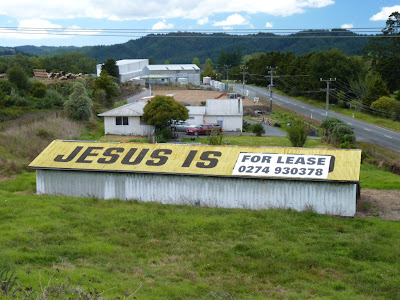It was a short bike ride to the dock in Picton from our little cove in Queen Charlotte Sound. From here we used a series of alternate modes to get us to the far north of New Zealand.
 |
| The viewing deck on the ferry is better than any big-screen TV. |
The ferry takes three hours to cross the channel to Wellington. I overheard a conversation between fellow passengers with the words "Christchurch" and "earthquake". It was not until we arrived at the hostel in Wellington that we learned that there had been a major aftershock the previous day while we were waiting out the rain in our little tent, removed from the news of the world. As a result, the availability of rooms was limited, and we did not have advance reservations. So John was assigned to a bunk in one dorm, and I was assigned to a bunk in another.
When I went to stash my belongings in my room, the other three occupants were not there, but open suitcases and clothing were strewn about. My stereotypical judgement was that, hum, these were not your typically tidy women. It was not until later in the evening, when John and I had said our goodnights and parted to our separate sleeping places that I actually met my roommates. I don't know who was more surprised, the guy wrapped in a towel or me, that I had been placed in an all-male dorm.
Due to the earthquake and the interruption of traveller's connections, the hostel was packed and the staff was trying to accomodate everyone. They filled all the rooms and even had people sleeping on the floor of the TV lounge. When I went to the front desk to inquire why I had been put in that room, I felt a bit chastised when I was reminded people in Christchurch were sleeping in school gymnasiums becuase their houses were no longer standing. So, being the modest type, I piled my things in a corner, went to bed, and rose before the dawn and slipped out before anyone else in the room woke up.
The earthquake dominated the media and conversation all around us. We sat that first night in the hostel and watched the televison coverage. We recognized many of the buildings that we had seen just 10 days before when we were in Christchurch, now crumbled and destroyed. But what made this aftershock different that the initial quake in September was that there was loss of life. This was just the first day after the event, so there were people still missing and trapped in the rubble. To see the hope and despair of the family members holding vigil brought us both to tears.
We spent one more night in Wellington (this time in the same room), and the next morning left the hostel before dawn to cycle to the train station. We boarded the
Overlander train, and for the next 12 hours we rolled through green countryside, crossed over impossible trestles, and
wound in circles up grades on our way to Auckland. We decided to skip cycling the south half of the North Island, and instead explore the region to the north of Auckland, known as the Northland (oddly enough), in our remaining month on the island. We spent two more nights in a hostel in Auckland, with a fruitful day searching for bike boxes for our return flight home. After traveling the last three months on the sparsely populated South Island, the bustle of Auckland was a bit overwhelming, and we were anxious to burn off those bowls of laksa and get biking again.
 |
| All aboard! |
 |
| The landscape passes by very quickly in a train, as compared to our snail's pace on a bicycle. |
Auckland and the surrounding suburban area occupy an isthmus at the top third of the North Island. It is a choke point, and there is no easy way to get past the urban area. Highway 1 is the main artery out of the city, and all our travel guides and conversations with other cyclists recommended that we not try and bike it. So we took a bus from Auckland city center to a roadside stop at the
Swinging Cow Cafe, two hours north. It was a huge bus, like so many that have passed us on the road and sucked us into their wake. Our bikes were able to stand upright in the luggage compartments, still fully loaded with the panniers. The bus stopped just long enough for us to get off and claim our bikes, and off it went leaving only the smell of diesel behind.
 |
| A most colorful bus depot. |
After four days of noise, relative chaos, and sad earthquake news, we were again standing on the side of the road, feeling like we had been teleported back to the green rolling hills of the Shire. We were safe, we were together, and we were happy.
 |
| Happy, happy, happy, to be self-propelled again! |


















































